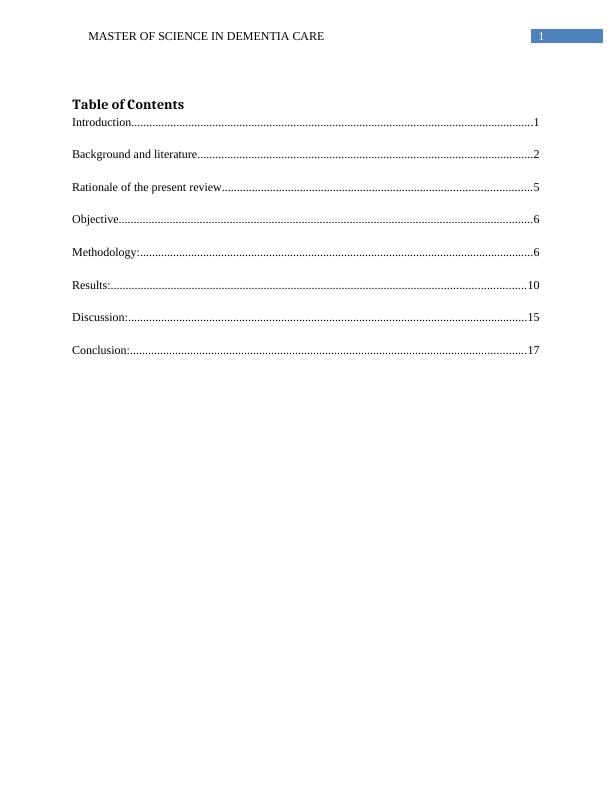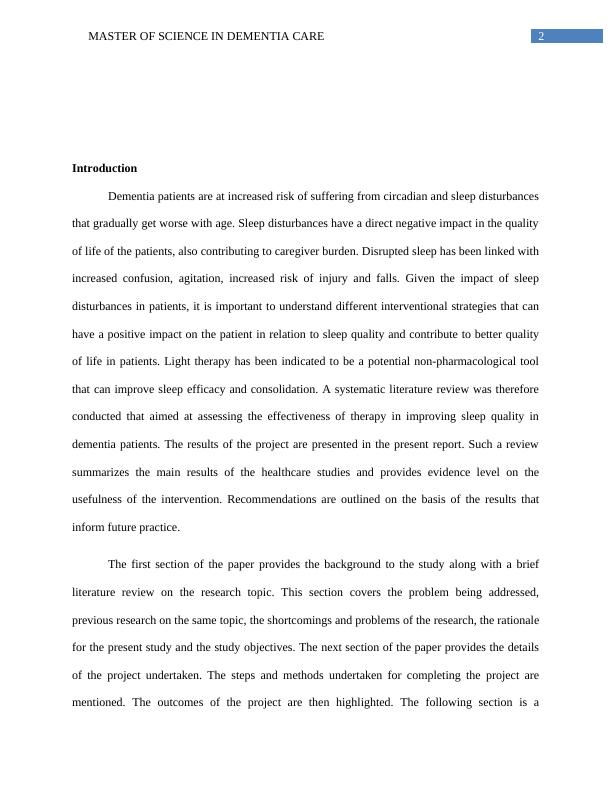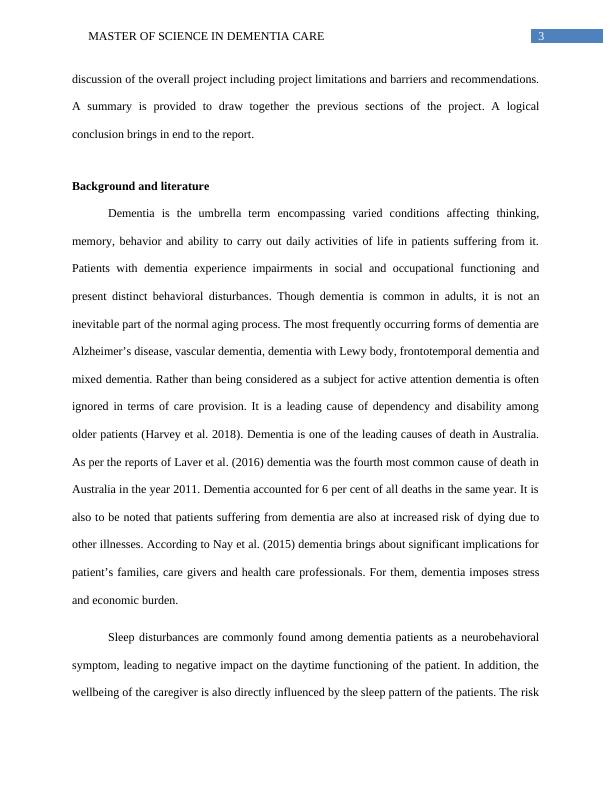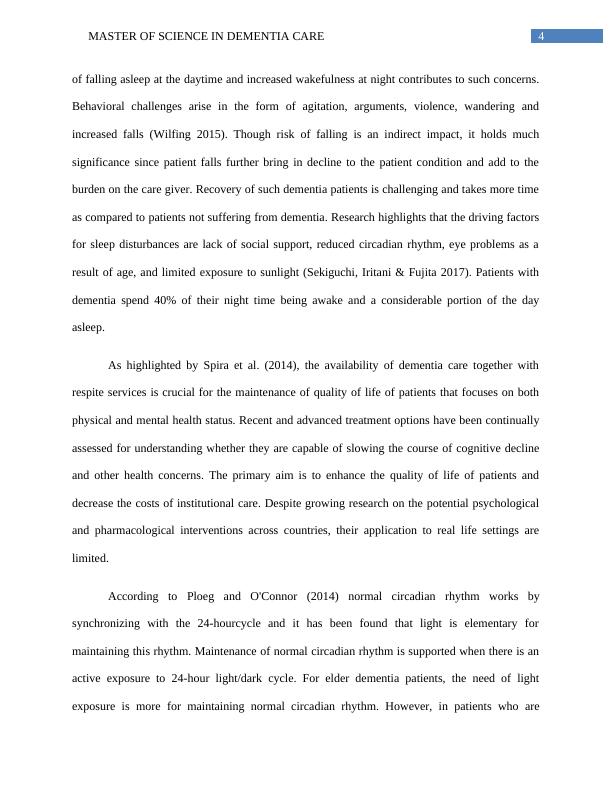Effectiveness of Light Therapy in Improving Sleep Quality in Dementia Patients
Added on 2023-06-11
23 Pages5870 Words463 Views
Running head: MASTER OF SCIENCE IN DEMENTIA CARE
Master of Science in dementia care
Name of the student:
Name of the University:
Author’s note
Master of Science in dementia care
Name of the student:
Name of the University:
Author’s note

1MASTER OF SCIENCE IN DEMENTIA CARE
Table of Contents
Introduction......................................................................................................................................1
Background and literature................................................................................................................2
Rationale of the present review.......................................................................................................5
Objective..........................................................................................................................................6
Methodology:...................................................................................................................................6
Results:..........................................................................................................................................10
Discussion:.....................................................................................................................................15
Conclusion:....................................................................................................................................17
Table of Contents
Introduction......................................................................................................................................1
Background and literature................................................................................................................2
Rationale of the present review.......................................................................................................5
Objective..........................................................................................................................................6
Methodology:...................................................................................................................................6
Results:..........................................................................................................................................10
Discussion:.....................................................................................................................................15
Conclusion:....................................................................................................................................17

2MASTER OF SCIENCE IN DEMENTIA CARE
Introduction
Dementia patients are at increased risk of suffering from circadian and sleep disturbances
that gradually get worse with age. Sleep disturbances have a direct negative impact in the quality
of life of the patients, also contributing to caregiver burden. Disrupted sleep has been linked with
increased confusion, agitation, increased risk of injury and falls. Given the impact of sleep
disturbances in patients, it is important to understand different interventional strategies that can
have a positive impact on the patient in relation to sleep quality and contribute to better quality
of life in patients. Light therapy has been indicated to be a potential non-pharmacological tool
that can improve sleep efficacy and consolidation. A systematic literature review was therefore
conducted that aimed at assessing the effectiveness of therapy in improving sleep quality in
dementia patients. The results of the project are presented in the present report. Such a review
summarizes the main results of the healthcare studies and provides evidence level on the
usefulness of the intervention. Recommendations are outlined on the basis of the results that
inform future practice.
The first section of the paper provides the background to the study along with a brief
literature review on the research topic. This section covers the problem being addressed,
previous research on the same topic, the shortcomings and problems of the research, the rationale
for the present study and the study objectives. The next section of the paper provides the details
of the project undertaken. The steps and methods undertaken for completing the project are
mentioned. The outcomes of the project are then highlighted. The following section is a
Introduction
Dementia patients are at increased risk of suffering from circadian and sleep disturbances
that gradually get worse with age. Sleep disturbances have a direct negative impact in the quality
of life of the patients, also contributing to caregiver burden. Disrupted sleep has been linked with
increased confusion, agitation, increased risk of injury and falls. Given the impact of sleep
disturbances in patients, it is important to understand different interventional strategies that can
have a positive impact on the patient in relation to sleep quality and contribute to better quality
of life in patients. Light therapy has been indicated to be a potential non-pharmacological tool
that can improve sleep efficacy and consolidation. A systematic literature review was therefore
conducted that aimed at assessing the effectiveness of therapy in improving sleep quality in
dementia patients. The results of the project are presented in the present report. Such a review
summarizes the main results of the healthcare studies and provides evidence level on the
usefulness of the intervention. Recommendations are outlined on the basis of the results that
inform future practice.
The first section of the paper provides the background to the study along with a brief
literature review on the research topic. This section covers the problem being addressed,
previous research on the same topic, the shortcomings and problems of the research, the rationale
for the present study and the study objectives. The next section of the paper provides the details
of the project undertaken. The steps and methods undertaken for completing the project are
mentioned. The outcomes of the project are then highlighted. The following section is a

3MASTER OF SCIENCE IN DEMENTIA CARE
discussion of the overall project including project limitations and barriers and recommendations.
A summary is provided to draw together the previous sections of the project. A logical
conclusion brings in end to the report.
Background and literature
Dementia is the umbrella term encompassing varied conditions affecting thinking,
memory, behavior and ability to carry out daily activities of life in patients suffering from it.
Patients with dementia experience impairments in social and occupational functioning and
present distinct behavioral disturbances. Though dementia is common in adults, it is not an
inevitable part of the normal aging process. The most frequently occurring forms of dementia are
Alzheimer’s disease, vascular dementia, dementia with Lewy body, frontotemporal dementia and
mixed dementia. Rather than being considered as a subject for active attention dementia is often
ignored in terms of care provision. It is a leading cause of dependency and disability among
older patients (Harvey et al. 2018). Dementia is one of the leading causes of death in Australia.
As per the reports of Laver et al. (2016) dementia was the fourth most common cause of death in
Australia in the year 2011. Dementia accounted for 6 per cent of all deaths in the same year. It is
also to be noted that patients suffering from dementia are also at increased risk of dying due to
other illnesses. According to Nay et al. (2015) dementia brings about significant implications for
patient’s families, care givers and health care professionals. For them, dementia imposes stress
and economic burden.
Sleep disturbances are commonly found among dementia patients as a neurobehavioral
symptom, leading to negative impact on the daytime functioning of the patient. In addition, the
wellbeing of the caregiver is also directly influenced by the sleep pattern of the patients. The risk
discussion of the overall project including project limitations and barriers and recommendations.
A summary is provided to draw together the previous sections of the project. A logical
conclusion brings in end to the report.
Background and literature
Dementia is the umbrella term encompassing varied conditions affecting thinking,
memory, behavior and ability to carry out daily activities of life in patients suffering from it.
Patients with dementia experience impairments in social and occupational functioning and
present distinct behavioral disturbances. Though dementia is common in adults, it is not an
inevitable part of the normal aging process. The most frequently occurring forms of dementia are
Alzheimer’s disease, vascular dementia, dementia with Lewy body, frontotemporal dementia and
mixed dementia. Rather than being considered as a subject for active attention dementia is often
ignored in terms of care provision. It is a leading cause of dependency and disability among
older patients (Harvey et al. 2018). Dementia is one of the leading causes of death in Australia.
As per the reports of Laver et al. (2016) dementia was the fourth most common cause of death in
Australia in the year 2011. Dementia accounted for 6 per cent of all deaths in the same year. It is
also to be noted that patients suffering from dementia are also at increased risk of dying due to
other illnesses. According to Nay et al. (2015) dementia brings about significant implications for
patient’s families, care givers and health care professionals. For them, dementia imposes stress
and economic burden.
Sleep disturbances are commonly found among dementia patients as a neurobehavioral
symptom, leading to negative impact on the daytime functioning of the patient. In addition, the
wellbeing of the caregiver is also directly influenced by the sleep pattern of the patients. The risk

4MASTER OF SCIENCE IN DEMENTIA CARE
of falling asleep at the daytime and increased wakefulness at night contributes to such concerns.
Behavioral challenges arise in the form of agitation, arguments, violence, wandering and
increased falls (Wilfing 2015). Though risk of falling is an indirect impact, it holds much
significance since patient falls further bring in decline to the patient condition and add to the
burden on the care giver. Recovery of such dementia patients is challenging and takes more time
as compared to patients not suffering from dementia. Research highlights that the driving factors
for sleep disturbances are lack of social support, reduced circadian rhythm, eye problems as a
result of age, and limited exposure to sunlight (Sekiguchi, Iritani & Fujita 2017). Patients with
dementia spend 40% of their night time being awake and a considerable portion of the day
asleep.
As highlighted by Spira et al. (2014), the availability of dementia care together with
respite services is crucial for the maintenance of quality of life of patients that focuses on both
physical and mental health status. Recent and advanced treatment options have been continually
assessed for understanding whether they are capable of slowing the course of cognitive decline
and other health concerns. The primary aim is to enhance the quality of life of patients and
decrease the costs of institutional care. Despite growing research on the potential psychological
and pharmacological interventions across countries, their application to real life settings are
limited.
According to Ploeg and O'Connor (2014) normal circadian rhythm works by
synchronizing with the 24-hourcycle and it has been found that light is elementary for
maintaining this rhythm. Maintenance of normal circadian rhythm is supported when there is an
active exposure to 24-hour light/dark cycle. For elder dementia patients, the need of light
exposure is more for maintaining normal circadian rhythm. However, in patients who are
of falling asleep at the daytime and increased wakefulness at night contributes to such concerns.
Behavioral challenges arise in the form of agitation, arguments, violence, wandering and
increased falls (Wilfing 2015). Though risk of falling is an indirect impact, it holds much
significance since patient falls further bring in decline to the patient condition and add to the
burden on the care giver. Recovery of such dementia patients is challenging and takes more time
as compared to patients not suffering from dementia. Research highlights that the driving factors
for sleep disturbances are lack of social support, reduced circadian rhythm, eye problems as a
result of age, and limited exposure to sunlight (Sekiguchi, Iritani & Fujita 2017). Patients with
dementia spend 40% of their night time being awake and a considerable portion of the day
asleep.
As highlighted by Spira et al. (2014), the availability of dementia care together with
respite services is crucial for the maintenance of quality of life of patients that focuses on both
physical and mental health status. Recent and advanced treatment options have been continually
assessed for understanding whether they are capable of slowing the course of cognitive decline
and other health concerns. The primary aim is to enhance the quality of life of patients and
decrease the costs of institutional care. Despite growing research on the potential psychological
and pharmacological interventions across countries, their application to real life settings are
limited.
According to Ploeg and O'Connor (2014) normal circadian rhythm works by
synchronizing with the 24-hourcycle and it has been found that light is elementary for
maintaining this rhythm. Maintenance of normal circadian rhythm is supported when there is an
active exposure to 24-hour light/dark cycle. For elder dementia patients, the need of light
exposure is more for maintaining normal circadian rhythm. However, in patients who are

5MASTER OF SCIENCE IN DEMENTIA CARE
institutionalized, the scope of being exposed to sunlight is minimal. A rich pool of studies has
established the positive impact of bright light in dementia patients. Nevertheless, the outcomes of
the studies are not similar. The main findings of the paper indicate improved mood and sleep
patterns among patients (Most, Scheltens & Van Someren 2010).
The researchers brought into limelight how light therapy might work for dementia
patients. The hypothalamic suprachiasmatic nucleus (SCN) has the function of being a circadian
pacemaker. This implied that there is a synchronization with the day and night cycle through
light. This synchronization is to be perceived as extremely sensitive. For dementia patients, there
is a considerable reduction in SCN since the activity and sensitivity is reduced. The ultimate
outcome is disturbed sleep patterns due to severe disruption in sleep. Such disturbances are
rerated to loss of vasopressin in SCN. Thus, exposure to light on a regular basis helps in
reactivating the SCN and stabilizing the 24-hour light dark cycle. The intervention has been
widely assessed for its benefits and effectiveness in dementia patients, mainly those who reside
in care facilities. The researchers highlighted how lighting characteristics affect circadian
rhythms. The neural machinery in the mammalian retina provides light information to both
the visual and circadian system. The quantity of polychromatic light required for activating
the circadian system is at least two orders of magnitude more than the amount that activates
the visual system. The circadian system is dependent on the timing of light exposure. The
higher exposure to light at the time of day the lower is the sensitivity of the circadian system to
light. Light information is known to travel from the retina to the SCN through the
retinohypothalamic tract (RHT). When there are considerable disturbances in the circadian
rhythms, older adults undergo poor sleeping pattern as the pathway is dysfunctional, leading
institutionalized, the scope of being exposed to sunlight is minimal. A rich pool of studies has
established the positive impact of bright light in dementia patients. Nevertheless, the outcomes of
the studies are not similar. The main findings of the paper indicate improved mood and sleep
patterns among patients (Most, Scheltens & Van Someren 2010).
The researchers brought into limelight how light therapy might work for dementia
patients. The hypothalamic suprachiasmatic nucleus (SCN) has the function of being a circadian
pacemaker. This implied that there is a synchronization with the day and night cycle through
light. This synchronization is to be perceived as extremely sensitive. For dementia patients, there
is a considerable reduction in SCN since the activity and sensitivity is reduced. The ultimate
outcome is disturbed sleep patterns due to severe disruption in sleep. Such disturbances are
rerated to loss of vasopressin in SCN. Thus, exposure to light on a regular basis helps in
reactivating the SCN and stabilizing the 24-hour light dark cycle. The intervention has been
widely assessed for its benefits and effectiveness in dementia patients, mainly those who reside
in care facilities. The researchers highlighted how lighting characteristics affect circadian
rhythms. The neural machinery in the mammalian retina provides light information to both
the visual and circadian system. The quantity of polychromatic light required for activating
the circadian system is at least two orders of magnitude more than the amount that activates
the visual system. The circadian system is dependent on the timing of light exposure. The
higher exposure to light at the time of day the lower is the sensitivity of the circadian system to
light. Light information is known to travel from the retina to the SCN through the
retinohypothalamic tract (RHT). When there are considerable disturbances in the circadian
rhythms, older adults undergo poor sleeping pattern as the pathway is dysfunctional, leading

End of preview
Want to access all the pages? Upload your documents or become a member.
Related Documents
Research in Nursing - Assignment PDFlg...
|12
|3330
|72
Benefits of Music Therapy on Dementia Patientslg...
|16
|4802
|42
The impact of music therapy on wellbeing of dementia patientslg...
|12
|2931
|182
Critical Research Appraisal: Assessment 3lg...
|4
|1371
|34
Mental Health Nursing - PDFlg...
|29
|7775
|171
Dementia Quality of Care - Doclg...
|7
|1625
|96
